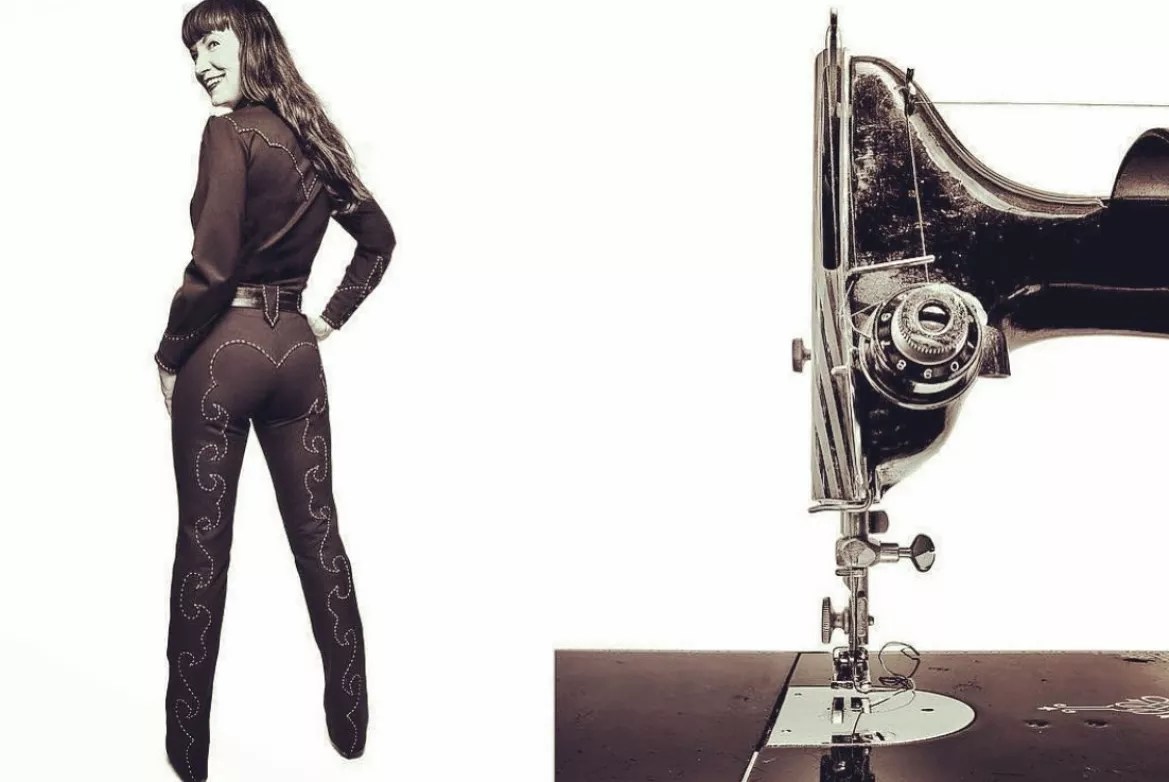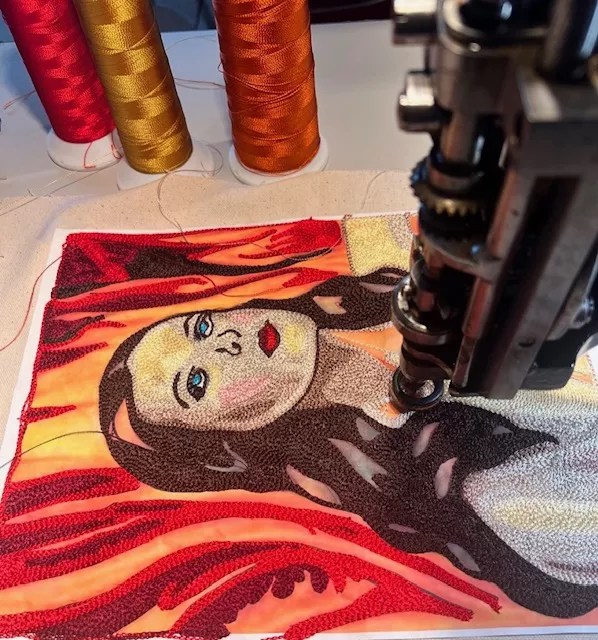
Andrea Heath

Audio By Carbonatix
With the recent resurgence of Western style, classic chain stitching has become a micro-trend embraced by everyone from Bill Murray to Post Malone, who proudly sport shirts and suits adorned with everything from armadillos to flaming dice.
Although the craft dates back to 5th-century China, modern chain stitching was invented by Ercole Cornely in Paris in 1865 as a quicker way to embroider. Popular with the Victorians, it became even more beloved in the 1940s and ’50s by Western stars like Roy Rogers, who embraced elaborately stitched suits made by the likes of Nudie Cohn.
As the wife of the rockabilly artist The Reverend Horton Heat, Andrea Heath was always fond of the look. Finding herself with many events to attend (and nothing off the rack to wear), she decided to sew curve-hugging cowgirl styles based on vintage patterns, with topstitching and detailing added by hand.
Those early looks led to a burgeoning business where she balances work for corporate clients with unique designs for her husband. The Fort Worth native says getting into chain stitching was a natural evolution, as she was raised in a family adept at handwork.
Will you step up to support Dallas Observer this year?
At the Dallas Observer, we’re small and scrappy — and we make the most of every dollar from our supporters. Right now, we’re $14,000 away from reaching our December 31 goal of $30,000. If you’ve ever learned something new, stayed informed, or felt more connected because of the Dallas Observer, now’s the time to give back.
“I got my interest in sewing from my grandmothers,” she says. “My Austrian grandmother had a sewing machine, and my other grandmother was Italian – she worked at Koslow’s Furs. The linings would have to be hand-sewn, so that’s what she did.”
Initially getting into the fashion business as a teen model, Heath began working for the Reverend’s agent before they were a couple, moving to San Francisco for the job in the late ’80s. Returning to Texas in the ’90s to be closer to family, she landed a gig at Independent Artists Agency, where she styled for clients such as the Spiegel catalog and Neiman Marcus.
That led to a gig at JCPenney as a casting and styling director, where she worked for over a decade, learning the ins and outs of the fashion business.
“I just kind of landed in these things; it just kind of happened,” Heath says with a laugh. “Being at Penney’s in advertising, you learn how to take a good picture. It taught me a lot about photography and how to work in that corporate environment. It was all a learning experience, but ultimately it wasn’t for me.”
Heath decided to quit to spend more time with her two daughters and took over the Reverend’s online merchandising business, which kept her busy enough until the pandemic hit. Finding herself with time on her hands, Heath decided to splurge on her first chain stitching machine, which cost $2,500 and had to be shipped from England.

The artist (above) calls her work “Western Gothic.”
Jeff Stephens
“I’d gotten books on Western wear like this cool book, Hillybilly Hollywood,” Heath says. “The more I researched about the machines, the more I wanted one, but the expense was holding me back. I finally dipped into my retirement and bought one.”
This led to months of sleepless nights trying to figure out the process of drawing with thread. In fits and starts, Heath mastered her machine by watching YouTube videos. Drawing on the aesthetic she dubs “Western Gothic,” she began to craft simple patches until she refined her techniques.
“I think it took me three months before I got it,” she says. “Three months of sitting there every day until I didn’t break the thread or the needle. I just went with it. I still have some of the first patches I did, and they’re horrific, but I got used to it. Then someone found me online and hired me to create car club jackets.”
In Stitches
Those early designs led Heath to level up by creating large-scale stitched works based on imagery such as the Catholic Anima Sola (lonely soul), which pictures a woman in flames. From her Parker, Texas, atelier, she now presides over five sewing machines (two exclusively for chain stitching) to create her intricate designs.
Heath offers her work under the moniker of @chainedintexas on Instagram, where she shares projects ranging from art based on the Mexican game of Loteria to simple signatures on bandanas.

The artist’s work is in demand with big brands and musicians.
Andrea Heath
Brands Todd Snyder and Kendra Scott came calling. The latter has hired Heath 10 times over the last year to stitch silky scarves for pop-ups. She’s currently in the middle of her biggest project, sending embroidered panels illustrating barbed wire, bluebonnets and oil derricks to her husband’s tailor in Bali, Indonesia, for a one-of-a-kind suit.
Pricing her stitching at roughly $100 an hour (depending on the intricacy of the job), Heath anticipates larger pieces will run in the thousands – a fair price for all the time spent hand-lettering text, sketching designs, and stabilizing the material.
With an accidental side career as an extra for showrunner Taylor Sheridan (she recently worked with both Billy Bob Thornton and Michelle Pfeiffer), Heath is poised to expand her audience as she grows her chain stitching skill set.
As she adds to her files of fun fonts, old-school tattoo art and cowboy imagery for future projects, the artist has a straightforward goal: to share the blending of craft and human ingenuity that made the chain stitching machine possible.
“I’d just like to be recognized as a great chain stitcher and acknowledged among my peers,” she says. “I’d also like to do more suits and get people familiar with what chain stitching is. When I’m [in public] stitching bandanas, people just think it’s a sewing machine. The fact these machines are still running and will outlive me is just crazy. That they’re so old and are still relevant really says something.”